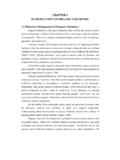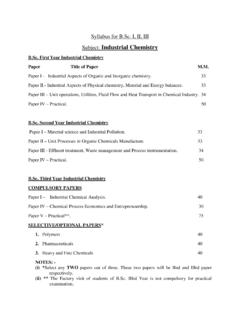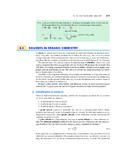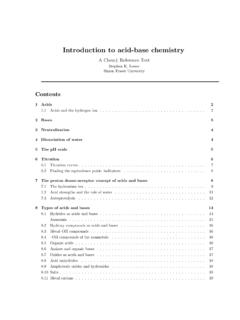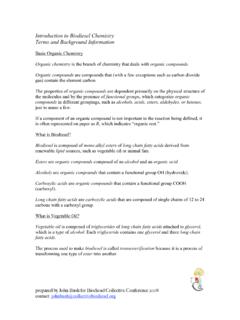Transcription of NCEA-C- 1282 EMASC-001 April 2002 - Introduction to …
1 NCEA-C- 1282 EMASC-001 April 2002 METHODS FOR THE DETERMINATION OF TOTAL organic CARBON (TOC) IN SOILS AND SEDIMENTS Brian A. Schumacher, United States Environmental Protection Agency Environmental Sciences Division National Exposure Research Laboratory Box 93478 Las Vegas,NV 89193-3478 Ecological Risk Assessment Support Center Office of Research and Development US. Environmental Protection Agency ACKNOWLEDGMENTS This document was prepared by Brian Schumacher of EPA*s National Exposure Research Laboratory, Office of Research and Development (ORD) in response to a request received by ORD*s Ecological Risk Assessment Support Center. Peer review of the document was conducted by Peter Landrum of the National Oceanographic and Atmospheric Administration, and Robert Ozretich of ORD*s National Health and Environmental Effects Research Laboratory.
2 Bruce Duncan, EPA Region 10, and Sharon Thorns, EPA Region 4, provided helpful insights and comments during the preparation of the document. Programmatic review of the document was conducted by the Trichairs of EPA*s Ecological Risk Assessment Forum: Steve Wharton, EPA Region 8; Bethany Grohs, Office of Solid Waste and Emergency Response, Office of Emergency and Remedial Response (OSWER/OERR); and Brenda Jones, EPA Region 5. Finally, we would like to acknowledge the efforts of Mark Sprenger, EPA/OSWER/OERR, in initiating the original request. ii 1. Introduction organic matter in soils and sediments is widely distributed over the earth*s surface occurring in almost all terrestrial and aquatic environments (Schnitzer, 1978). Soils and sediments contain a large variety of organic materials ranging from simple sugars and carbohydrates to the more complex proteins, fats, waxes, and organic acids.
3 Important characteristics of the organic matter include their ability to: form water-soluble and water insoluble complexes with metal ions and hydrous oxides; interact with clay minerals and bind particles together; sorb and desorb both naturally-occurring and anthropogenically-introduced organic compounds; absorb and release plant nutrients; and hold water in the soil environment. As a result of these characteristics, the determination of total organic carbon (a measure of one of the chemical components of organic matter that is often used as an indicator of its presence in a soil or sediment) is an essential part of any site characterization since its presence or absence can markedly influence how chemicals will react in the soil or sediment. Soil and sediment total organic carbon (TOC) determinations are typically requested with contaminant analyses as part of an ecological risk assessment data package.
4 TOC contents may be used qualitatively to assess the nature of the sampling location ( , was a depositional area) or may be used to normalize portions of the analytical chemistry data set ( , equilibrium partitioning). The purpose of this document, as defined by the Ecological Risk Assessment Forum, is to answer the question of What is the most appropriate method for soil and/or sediment TOC analyses and what factors should be considered when selecting the method? 2. SOURCES AND FORMS OF CARBON IN SOILS AND SEDIMENTS In soils and sediments, there are three basic forms of carbon that may be present. They are: (1) elemental C, (2) inorganic C, and (3) organic C. The quality of organic matter in sediments is critical to the partitioning and bioavailability of sediment-associated contaminants.
5 For example, Talley et al., 2002, demonstrated that although the majority of PAHs in a dredged sediment were found prefer entially on coal-derived particles, the PAHs on the clay/silt sediment fraction were more mobile and available, and thus potentially of greater concern. ELEMENTAL CARBON FORMSE lemental carbon forms include charcoal, soot, graphite, and coal. The primary sources for elemental carbon in soils and sediments are as incomplete combustion products of organic matter ( , charcoal, graphite, and soot), from geologic sources ( , graphite and coal), or dispersion of the these carbon forms during mining, processing, or combustion of these materials. 1 INORGANIC CARBON FORMS Inorganic carbon forms are derived from geologic or soil parent material sources.
6 Inorganic carbon forms are present in soils and sediments typically as carbonates. The two most common carbonate minerals found in soils and sediments are calcite (CaCO3) and dolomite [CaMg(CO3)2] although other forms may be present ( , siderite, FeCO3) depending on where the soils were formed or where the sediment source was located. It should be noted that calcite and to some extent, dolomite, may also be present in soils and sediments due to agricultural input ( , liming practices). organic CARBON FORMS Naturally-occurring organic carbon forms are derived from the decomposition of plants and animals. In soils and sediments, a wide variety of organic carbon forms are present and range from freshly deposited litter ( , leaves, twigs, branches) to highly decomposed forms such as humus.
7 In addition to the naturally-occurring organic carbon sources are sources that are derived as a result of contamination through anthropogenic activities. The spills or releases of con taminants into the environment increase the total carbon content present in the soil or sediment. In general, though, the total carbon contribution from contaminants (typically measured in the :g/kg to mg/kg concentration range) to the total organic carbon content (measured in the % range) of the soil or sediment is relatively small to negligible unless a fresh spill has occurred, pure product is present, or a hot spot is sampled. In contrast to spilled contaminants, various sites may contain discrete organic carbon bearing particles such as wood fibers from pulp mill wastes or leather scraps from tannery wastes.
8 At these locations, the total carbon content contribution of these wastes may be a significant to dominant fraction of the TOC determined for the sample. It should be noted that the methods for determining total organic carbon and total carbon contents generally do not distinguish between the sources of the organic carbon forms. Nonetheless, there arc two methods noted below that are capable of qualitatively identifying carbon forms in the soil/sediment, and two methods that analyze specific fractions of the TOC. 3. SAMPLE COLLECTION AND HANDLINGP rior to any analyses for TOC, the soil or sediment sample must be collected and properly handled. During the collection and handling of the samples, losses of organic compounds may occur due to: microbial degradation, sample drying, oxidation, volatilization, and sample processing biases ( , selective removal of carbon-bearing components).
9 Soil and sediment samples can be collected by numerous different tools but once collected, the samples are 2 typically stored at 4 C and have a holding time of up to 28 days. While microbial degradation is greatly reduced at 4 C, it is not completely stopped leading to some potential loss of organic materials. Prior to analysis, some methods may require or recommend drying (tither air drying or oven drying) of the sample. Samples that contain volatile organic compounds and those that have been in an anaerobic environment will undergo some loss of organic compounds when exposed to the atmosphere during drying. Volatilization losses may also occur due to poor sealing of the sample container. While these losses are generally small (probably <1% of the TOC content in a non-contaminated soil or sediment), they are noted here to inform the reader of these potential sources for carbon loss.
10 The collection and subsampling of a representative sample can be an area where organic matter is selectively removed from the soil or sediment and thus, the resultant TOC concentration will be affected. The main concern in obtaining the representative sample for analysis is what to do when there are large, discrete particles of organic matter present in the sample. For example, a sediment sample might contain part of a tree branch or a soil sample might contain wood chips. The larger particles may be removed by physically pulling the particles out of the sample or by sieving the sample. Typically, the larger particles are relatively inert chemically and thus do not contribute significantly to the soil or sediment*s capacity to sorb or release contaminants. Removal of the larger organic particles, therefore, may lead to a more accurate assessment of the sample*s TOC fraction that does interact with the contaminants and biota in the soil or sediment.

